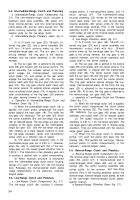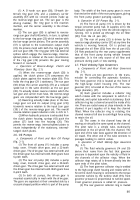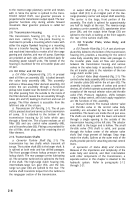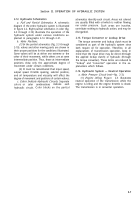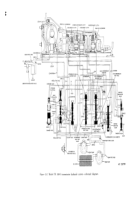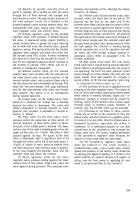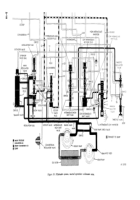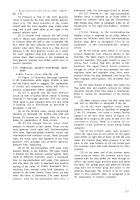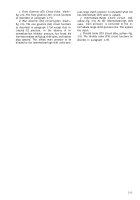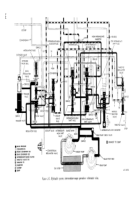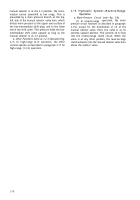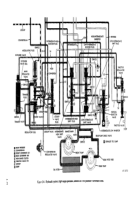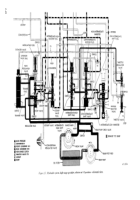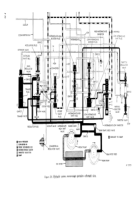TM-9-2520-254-34 - Page 23 of 126
throttle valve (TV) pressure is connected to the
throttle (T) pressure circuit. From this point, and
throughout the remaining throttle opening
movement, TV and T pressures are equal. Both
increase as the throttle is opened. Throttle (T)
pressure is directed to the upper surface areas of the
low-intermediate shift valve, intermediate-high
shift valve, and the lockup valve.
(2) At the low-intermediate shift valve, T
pressure is exerted downward on the shift valve and
upward on the blocker plug. This pressure tends to
hold the shift valve downward against the low-
intermediate shift plug which is being pushed
upward by G2 pressure. Thus, throttle opening
delays upshifting. The greater throttle opening is,
the greater is upshift delay.
(3) At the intermediate-high shift valve, the
effect of T pressure is identical to that described in
(2) above. However, the transmission speed range
(and G2 pressure range) within which the
movement of each of the shift values occurs is
different. This difference is caused by the difference
in spring loads and plug areas against which G2
pressure works. Thus, the low-intermediate shift
valve, working with the lighter spring and greater
plug area, will upshift at a lower vehicle speed (and
G2 pressure) than will the intermediate-high shift
valve.
(4) At the lockup valve, T pressure delays the
upward movement of the lockup valve and thus
delays lockup.
The delay varies with throttle
opening. Should the throttle be closed completely
while the transmission is in low range, there would
be no T pressure or TV pressure to inhibit the
upward movement of the lockup valve.
(5) Throttle (TP) pressure can cause a
downshift at full throttle under certain conditions
as well as preventing an upshift under some con-
ditions. T pressure can also cause a change from
lockup operation to converter operation by moving
the lockup valve downward. Input and output
speed and governor (G1 and G2) pressures in-
fluence the point at which upshifts, downshifts, or
lockup occur when the throttle is manipulated.
h. Inhibitor Pressure Circuit
(dotted red—fig. 2-
4).
(1) In low-range operation, the intermediate-
low and high-intermediate inhibitor circuits are
charged. The only function of these pressures in
low-range operation is to prevent the upshifting of
either shift valve.
(2) In the intermediate-low inhibitor circuit,
oil enters (from main) through an orifice and exerts
pressure against the upper surface areas of the
inhibitor valve and the blocker plug. The inhibitor
valve moves downward against its spring and
allows oil to escape from the exhaust port at the left
side of the valve bore. The escape of oil at the
exhaust port, coupled with the limited flow caused
by the restriction in the feed line, causes a reduced
pressure in the inhibitor circuit. This reduced
pressure is calibrated against the downward force
required to downshift the low-intermediate shift
valve at a specific vehicle speed (and specific G2
pressure).
(3) In the high-intermediate inhibitor circuit,
hydraulic action is identical to that described in (2)
above, except that calibration of the pressure is to
that required to downshift the intermediate-high
shift valve.
(4) In low range, oil escapes continuously at
the exhaust ports in the inhibitor bores.
i. Lockup Clutch Circuit
(blue, white—fig. 2-4).
When the lockup valve is upward, main pressure
supplies the lockup feed line. When the flow valve
is upward, pressure in the lockup feed line supplies
oil to the lockup clutch circuit. Lockup pressure
applies the lockup clutch.
2-16. Hydraulic System—Intermediate-Range
Operation
a. Main Pressure Circuit
(red—fig. 2-5).
(1) The main pressure circuit in intermediate
range functions as described in paragraph 2-15a
for low-range operation except for the differences
outlined in
(a)
through (e) below.
(a)
Main pressure is cut off from the passage
(line 2) leading to the intermediate-low inhibitor
circuit.
(b)
Main pressure is extended from the low-
intermediate shift valve bore to the intermediate-
high shift valve bore.
(c)
Because a clutch (intermediate range) is
in the initial stage of being charged, there is a rapid
flow of oil through the orifice at the left side of the
flow valve. This reduces the pressure downstream
of the orifice and causes the flow valve to move
downward.
(d)
The downward position of the flow valve
temporarily releases lockup clutch pressure. In
addition, main pressure is cut off from the line
leading to the area above the extender valve ball.
This permits pressure above the trimmer plug to
escape past the extender valve ball and to exhaust
finally through the same port at the right of the flow
valve bore through which lockup pressure exhausts.
(e)
Release of pressure above the trimmer
plug permits the trimmer plug to move upward.
This, in turn, permits the trimmer valve to move
upward until main pressure escapes at the exhaust
port at the left of the trimmer valve bore.
(2) The results of the differences in the main
pressure circuit are explained in the various circuit
explanations which follow.
b.
Converter-In Circuit
(yellow—fig. 2-5). The
converter-in
circuit functions
as described in
paragraph 2-15b.
2-14
Back to Top

